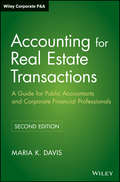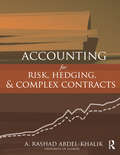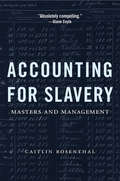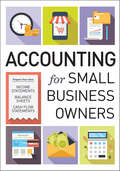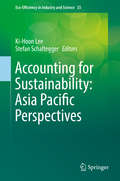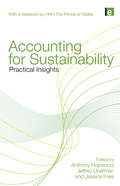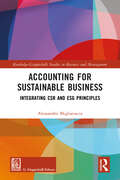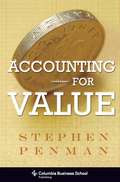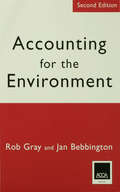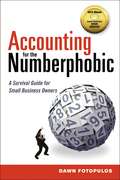- Table View
- List View
Accounting for Pensions and Employee Benefits at Ford and Toyota
by Gregory S. Miller Douglas J. Skinner Laura E. DonohueUses Ford's and Toyota's financial statements to familiarize students with the information provided in pension footnotes. Allows students to combine that information with other financial statement information to create a greater understanding of the costs of each company's business. Includes directive questions.
Accounting for Political Risk at AES (B)
by Suraj Srinivasan Gerardo Perez CavazosAccounting for Political Risk at AES (B) by Gerardo Pérez Cavazos and Suraj Srinivasan Supplement to the (A) case, HBS No. 118-023
Accounting for Productivity Growth
by Forest ReinhardtIntroduces students to the arithmetic of the accounting for national productivity growth. It defines labor productivity, capital productivity, and total factor productivity, describes the relationships among them, and discusses the phenomena that cause them to change over time. Exhibits include data for the United States and other industrial countries, which both show the relationships among the various measures and allow comparison across time and space. The end of the note discusses the 1992 controversy over productivity growth in Singapore. Productivity is an important phenomenon, widely discussed in the newspapers, but rarely even defined. Business students, especially those engaged in country analysis, need to understand the various ways in which it is measured and why those various quantities have changed over time in different nations. Intended for an introductory MBA course.
Accounting for Property, Plant, Equipment and Other Assets
by William J. Bruns Jr.An introduction to depreciation accounting and depreciation methods for capital assets. Also covers gains or losses on asset disposal and accounting for other investments and intangibles.
Accounting for Real Estate Transactions
by Maria K. DavisAccounting for Real Estate Transactions, Second Edition is an up-to-date, comprehensive reference guide, specifically written to help professionals understand and apply the accounting rules relating to real estate transactions. This book provides financial professionals with a powerful tool to evaluate the accounting consequences of specific deals, enabling them to structure transactions with the accounting consequences in mind, and to account for them in accordance with US GAAP. Accountants and auditors are provided with major concepts, clear and concise explanations of real estate accounting rules, detailed applications of US GAAP, flowcharts, and exhaustive cross-references of the authoritative literature.
Accounting for Risk, Hedging and Complex Contracts
by A. Rashad Abdel-KhalikWith the exponential growth in financial derivatives, accounting standards setters have had to keep pace and devise new ways of accounting for transactions involving these instruments, especially hedging activities. Accounting for Risk, Hedging and Complex Contracts addresses the essential elements of these developments, exploring accounting as related to today's most relevant topics - risk, hedging, insurance, reinsurance, and more. The book begins by providing a basic foundation by discussing the concepts of risk, risk types and measurement, and risk management. It then introduces readers to the nature and valuation of free standing options, swaps, forward and futures as well as of embedded derivatives. Discussion and illustrations of the cash flow hedge and fair value hedge accounting treatments are offered in both single currency and multiple currency environments, including hedging net investment in foreign operations. The final chapter is devoted to the disclosure of financial instruments and hedging activities. The combination of these topics makes the book a must-have resource and reference in the field. With discussions of the basic tools and instruments, examinations of the related accounting, and case studies to help students apply their knowledge, this book is an essential, self-contained source for upper-level undergraduate and masters accounting students looking develop an understanding of accounting for today’s financial realities.
Accounting for Slavery: Masters and Management
by Caitlin RosenthalCaitlin Rosenthal explores quantitative management practices on West Indian and Southern plantations, showing how planter-capitalists built sophisticated organizations and used complex accounting tools. By demonstrating that business innovation can be a byproduct of bondage Rosenthal further erodes the false boundary between capitalism and slavery.
Accounting for Slavery: Masters and Management
by Caitlin RosenthalCaitlin Rosenthal explores quantitative management practices on West Indian and Southern plantations, showing how planter-capitalists built sophisticated organizations and used complex accounting tools. By demonstrating that business innovation can be a byproduct of bondage Rosenthal further erodes the false boundary between capitalism and slavery.
Accounting for Small Business Owners
by Tycho PressAll the financial accounting a small business will ever needOwning and running a small business can be complicated. On top of developing, marketing and selling your product or service, you've got to be prepared to handle the money thats coming in, pay your employees, track expenditures, consider your stock options, and much more.Accounting for Small Business Owners covers the entire process of establishing solid accounting for your business and common financial scenarios, and will show you how to:Set up and run your businessManage and sell your product or servicePerform a month-end balancing of accountsPacked with definitions of basic accounting terms, sample accounting statements, and a wealth of tips and tricks to simplify the accounting process, Accounting for Small Business Owners has everything you need to get the job done!
Accounting for Social Risk Factors in Medicare Payment: Identifying Social Risk Factors
by Engineering Medicine National Academies of SciencesRecent health care payment reforms aim to improve the alignment of Medicare payment strategies with goals to improve the quality of care provided, patient experiences with health care, and health outcomes, while also controlling costs. These efforts move Medicare away from the volume-based payment of traditional fee-for-service models and toward value-based purchasing, in which cost control is an explicit goal in addition to clinical and quality goals. Specific payment strategies include pay-for-performance and other quality incentive programs that tie financial rewards and sanctions to the quality and efficiency of care provided and accountable care organizations in which health care providers are held accountable for both the quality and cost of the care they deliver. Accounting for Social Risk Factors in Medicare Payment: Identifying Social Risk Factors is the first in a series of five reports commissioned to provide input into whether socioeconomic status (SES) and other social risk factors could be accounted for in Medicare payment and quality programs. This report focuses on defining SES and other social factors for the purposes of application to Medicare quality measurement and payment programs.
Accounting for Social Value
by Laurie MookWhen organizations use social accounting practices, they are able to measure their performance in terms of benefits accrued to key stakeholders such as their communities, human resources, and those investing in the organization. This innovative change in accounting can lead to a fundamentally different perspective on the value of an organization. Through case studies of organizations that have implemented social accounting in the United States, Canada, India, and Scotland, Accounting for Social Value provides a unique perspective for understanding key issues in this growing field.Building on two related titles, Researching the Social Economy (2010) and Businesses with a Difference (2012), Accounting for Social Value offers academics, accountants, policy-developers, and members of non-profit, co-operative, and for-profit organizations tools and insights to explore the connections between economic, social, and environmental dimensions. The lessons learned are valuable not only for other social economy organizations, but also for organizations in the public and for-profit sectors.
Accounting for Social and Environmental Sustainability: A Multi-Capital Approach (Routledge Studies in Accounting)
by Delphine GibassierFor a company, managing its social and environmental performance is no longer just a matter of reducing its impact; it must also be able to assess its contribution to resolving or aggravating social and environmental problems. This book argues that the current work on accounting for sustainability has not yet given organisations a tool to integrate their performance within the planetary and social framework that conveys actual "planetary and social budgets", and that business organisations lack the possibility to go beyond incremental performance measurement.It offers an in‑depth examination of multi‑capital accounting, which has already been integrated within the Corporate Sustainability Reporting Directive and will follow on from sustainability reporting. The LIFTS model (Limits and Foundations Towards Sustainability Accounting Model) used in this book combines various scientific and practical contributions to develop budgets for environmental impacts and social obligations on an organisational scale. It proposes an accounting mechanism that enables an organization to manage each of its budgets and measure variances between forecast and actual. It provides an introduction to the principles of this model and its conditions of application and describes its implementation in numerous companies.While the main audience for the book is academics, advanced students and researchers in accounting for sustainability, business and management and economics, it will also appeal to practitioners, policymakers, national standard setters, think tanks and non-governmental organizations (NGOs).
Accounting for Steam and Cotton: Two Eighteenth Century Case Studies
by Robert B. WilliamsFirst published in 1988, this book arose from the author’s fascination with the period of the late eighteenth century and the two industries of cotton and steam that seem to characterise the period, the provision of power through the manufacture of steam engines and the rise to prominence of the cotton industry. Includes photographs and an exploration of people in these industries during the Industrial Revolution.
Accounting for Sustainability
by Gunnar RimmelThis book provides a broad overview of how sustainability reporting has grown, how it is used now and where it is heading. Daily, we read and hear in various media about concepts such as corporate social responsibility (CSR), sustainability reporting, sustainability accounting, environmental reports, corporate citizenship or environmental management systems. Accounting for Sustainability decodes this terminology by providing an accessible introduction to the topic that explores sustainability reporting from an internal and external perspective. It begins with an overview of how sustainability reporting has emerged and why it is important, before moving on to cover definitions of key terms and specific theories and frameworks. Subsequent chapters explore the role of financial management, sustainability standards, accounting communication and capital markets. With learning outcomes and study questions embedded in each chapter, this book will be of great interest to students of sustainability reporting and accounting, as well as practitioners taking related professional accreditations.
Accounting for Sustainability: Asia Pacific Perspectives (Eco-Efficiency in Industry and Science #33)
by Ki-Hoon Lee Stefan SchalteggerThis book advances the understanding of corporate sustainability and challenges and roles of sustainability accounting in the Asia-Pacific region. The Asia-Pacific region has shown fast economic growth for several decades which is expected to continue. In this context, Asia has become the "production engine" of the global economy. At the same time scientific reports reveal that some planetary boundaries are crossed, for example relating to biodiversity and climate change. Companies in the Asia-Pacific region are therefore increasingly challenged to reduce their environmental impacts, to document their social contribution and to contribute to sustainable development. Key approaches to identify sustainability problems and challenges, to support improvement processes and to back up sustainability contributions include accounting and reporting. In contrast to the high relevance of accounting and reporting for corporate sustainability for the Asia-Pacific region, academic research has so far been dominated by Western researchers and pre-dominantly dealt with Western and Japanese cases and approaches. It is thus time to take account of Asian perspectives on accounting and reporting for sustainability in the Asia-Pacific region.
Accounting for Sustainability: Practical Insights
by Jeffrey Unerman Anthony Hopwood Jessica FriesIf businesses and other organizations are to meet the many and complex challenges of sustainable development, then they all, both public and private, need to embed sustainability considerations into their decision-making and reporting. However, the translation of this aspiration into effective action is often inhibited by the lack of systems and procedures that take sustainability into account. Accounting for Sustainability: Practical Insights will help organizations to address these issues. The book sets out a number of tools and approaches that have been developed and applied by leading organizations to: - embed sustainability into decision-making, extending beyond an organization's boundaries to take into account suppliers, customers and other stakeholders; - measure and link sustainability and financial performance; - integrate sustainability into 'mainstream' reporting, both to management and external stakeholders. In-depth cases studies from Aviva, BT, the Environment Agency, EDF Energy, HSBC, Novo Nordisk, Sainsbury's and West Sussex County Council show in detail how accounting for sustainability works in practice in a wide range of organizational contexts. Published with The Prince's Charities: Accounting for Sustainability
Accounting for Sustainable Business: Integrating CSR and ESG Principles (Routledge-Giappichelli Studies in Business and Management)
by Alessandro MigliavaccaThe role of firms, corporations, and businesses in shaping social outcomes has long been a key area of focus for economics and business scholars. With growing attention on addressing climate change, reducing social inequalities, and upholding human rights, there is an increasing interest in how corporate activities impact society. This book examines these pressing issues through the lens of fundamental theories of the firm, particularly drawing on the Italian tradition of Economia Aziendale, which views the firm as a vehicle for meeting human needs and generating social value.The book begins by introducing the anthropocentric theory of the firm and explores the connection between accounting practices and sustainable management. It offers a thorough review of the literature on Corporate Social Responsibility (CSR) and Environmental, Social, and Governance (ESG) practices, highlighting key aspects of the extensive body of work in this field. The analysis is grounded in the context of evolving regulations, especially within the EU, that underscore the importance of considering both financial and sustainability factors. Rational management theory is expanded to include sustainability accounting, showcasing its pivotal role in corporate decision-making. The book provides detailed guidance on the integrated knowledge acquisition process, showing how companies can systematically identify and assess their social and environmental impacts. This process is further illustrated through a hypothetical reality-based case study, demonstrating its application in a practical context. The book concludes with an exploration of current trends and future directions in sustainability accounting.It serves as a valuable resource for academics, practitioners, and anyone interested in the intersection of corporate governance, accounting, and sustainability.
Accounting for Value
by Stephen PenmanDespite their skills and extensive training, many analysts fail to recognize the basics of good accounting and its deployment in valuation. By focusing on abstract concepts such as measurement basis, exit values, and entity concepts, they miss out on the benfits of a practical approach to valuation. While modern finance has advanced important concepts, including diversification and risk measurement, effective and efficient accounting merges these tools with fundamental analysis to divine a true account of value.Launching an innovative examination of equity valuation as a matter of accounting, Stephen Penman embraces the commonsense ideas of fundamentalists& mdash;good firms can be bad guys, the risk in investing is the risk of paying too much, ignore information at your own peril, beware of paying too much for growth& mdash;and combines them with the principles of modern finance to reestablish the parameters of good analysis. The result anchors the investor, guards against behavioral biases, and challenges speculation. Penman compares fair-value accounting and historical-cost accounting; describes the anchoring of cash flows, book value, and earnings; and details the failure of modern finance to correctly assess value. He concludes with fundamental strategies for accounting for value and a bold proposal for assessing the cost of capital. Altogether, Penman's text is an essential tool for interpreting the greatest financial challenges of our time: the stock market bubble of the 1990s, the credit crisis of 2008, and accounting in the wake of ongoing market instability.
Accounting for Value (Columbia Business School Publishing Ser.)
by Stephen PenmanAccounting for Value teaches investors and analysts how to handle accounting in evaluating equity investments. The book's novel approach shows that valuation and accounting are much the same: valuation is actually a matter of accounting for value. Laying aside many of the tools of modern finance-the cost-of-capital, the CAPM, and discounted cash flow analysis-Stephen Penman returns to the common-sense principles that have long guided fundamental investing: price is what you pay but value is what you get; the risk in investing is the risk of paying too much; anchor on what you know rather than speculation; and beware of paying too much for speculative growth. Penman puts these ideas in touch with the quantification supplied by accounting, producing practical tools for the intelligent investor.Accounting for value provides protection from paying too much for a stock and clues the investor in to the likely return from buying growth. Strikingly, the analysis finesses the need to calculate a "cost-of-capital," which often frustrates the application of modern valuation techniques. Accounting for value recasts "value" versus "growth" investing and explains such curiosities as why earnings-to-price and book-to-price ratios predict stock returns. By the end of the book, Penman has the intelligent investor thinking like an intelligent accountant, better equipped to handle the bubbles and crashes of our time. For accounting regulators, Penman also prescribes a formula for intelligent accounting reform, engaging with such controversial issues as fair value accounting.
Accounting for the Environment: Second Edition
by Jan Bebbington Robert H. Gray`This book is a good comprehensive text and comes highly recommended to anyone currently involved in, looking to get involved in, or just interested in environmental management, environmental accounting and reporting' - Pacific Accounting Review This is the long-awaited 2nd edition of the benchmark publication that helped shape the developing agenda of environmental accounting. This excellent new edition provides an overview of the subject ranging from environmental management to sustainability, and integrates the major advancements that have occurred since the first edition - in both research and practice. It introduces and explains environmental issues as they relate to accountants today. This new work also places an increased emphasis on the emerging research literature in the field and reveals a consciousness of the difficulties of developing an environmental agenda in business. It makes an excellent stand-alone text for lower level students, a firm base from which the advanced student or researcher can explore research and more complex issues, and a useful guide for practitioners seeking to understand and implement environmental practice.
Accounting for the Holocaust: Enabling the Final Solution (Routledge New Works in Accounting History)
by Michele Bigoni Warwick Funnell Erin TwyfordAccounting for the Holocaust: Enabling the Final Solution reveals how accounting practices allowed the attempted annihilation of Jews by the German Nazis and the Italian Fascists to be carried out with machine-like efficiency and devoid of any moral considerations.This largely hidden aspect of the Holocaust will allow a wide range of readers, both academic and across many sectors of the general population, to understand how the systematic murder of more than six million Jews was expedited by accounting practices and the information that these produced by allowing the humanity of those killed to be denied when they became mere numbers in a process. Readers will gain a new understanding of how the enactment of the scale of the Holocaust was made possible by the way in which accounting practices as “technologies of death” were used to reduce Jews to a life without value. The numerical calculations, techniques, and reports that constitute accounting practices allowed the systematic murder of Jews to be drained of any considerations that would imply that the numbers and costings were related to prescient human beings. These technologies of death also allowed those who managed and organised the murder of Jews to absolve themselves of the actual killings.
Accounting for the Intel Pentium Chip Flaw
by V. G. Narayanan Lisa Brem Gregory S. MillerInvestigates the 1994 Intel Pentium plan.
Accounting for the Numberphobic: A Survival Guide for Small Business Owners
by Dawn FotopulosWhy do so many business owners dread looking at the numbers? They make excuses...They don't have time...That's what the accountant is for....But the simple truth is that no one else will ever be as invested in their company as they are--and they need to take control. As a small-business owner, financial statements are your most important tools--and if you don't know how to read them and understand their implications, you cannot possibly steer your business successfully. Accounting for the Numberphobic demystifies your company's financial dashboard: the Net Income Statement, Cash Flow Statement, and Balance Sheet. The book explains in plain English how each measurement reflects the overall health of your business--and impacts your decisions. You will discover: How your Net Income Statement is the key to growing your profits * How to identify the break-even point that means your business is self-sustaining * Real-world advice on measuring and increasing cash flow * What the Balance Sheet reveals about your company's worth * And more Illustrated with case studies and packed with practical action steps, this indispensable guide will put your business on the path to profitability in no time.

